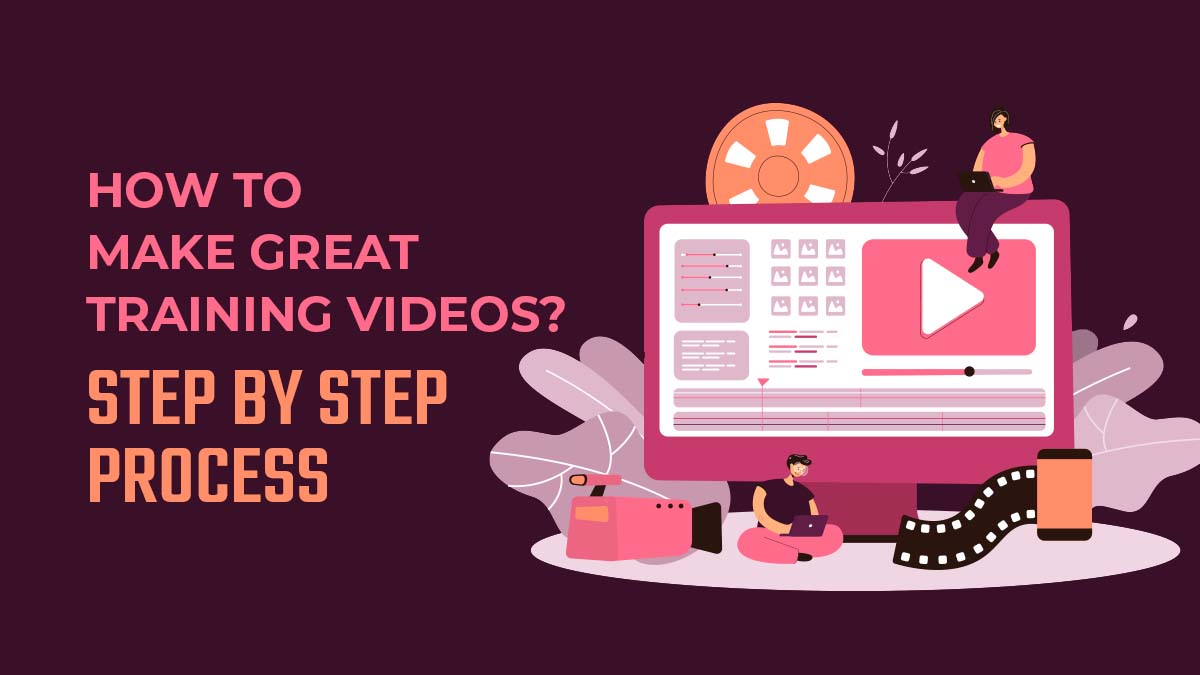A staggering 42% of companies have reported a noticeable increase in revenue figures after turning to e-learning as an educational solution for employees.
Also, 41.7% of the world’s 500 largest corporations use training videos for employee training.
This can be attributed to the fact that e-learning removes many traditional barriers associated with formal classroom learning, such as geographic and financial restrictions.
Through e-learning, employees can access course materials from anywhere, anytime, and at any pace.
The market for corporate e-learning is anticipated to grow in size by USD 44,908.64 million between 2022 and 2027, expanding at a CAGR of 12.19%.
But the million-dollar question here is
How to make training videos for your company in 2023?
In this article, we’re going to learn all about that!
Types of training videos
Training videos come in various formats, but which one is the best?
The selection of a video format depends on several factors, including the goals, resources at your disposal, budget, preferences, etc.
Here are they:
Animated video
Animation can be an excellent resource for imparting knowledge to staff members. In addition to making the material at hand more exciting and memorable, they can offer a more all-encompassing introduction to a process or concept that may be difficult to grasp in other ways.
Animated videos are frequently employed when introducing new employees to the company’s systems, processes, and procedures. This aids in making sure that everyone knows the rules and what is expected of them.
In this respect, animated movies are typically more successful than conventional means of training because of their intriguing visual character and capacity to deliver complicated topics in an easy-to-grasp way.
Animated videos aid in reducing confusion by offering a thorough explanation of ideas in a fun way by integrating music, images, animation, and text.
An additional benefit of animations is that they may be adapted to each audience, ensuring that the presented information is clear and relevant to each individual’s function within the business.
Animated movies may be utilized for more than just internal training; they can also be distributed to promote the business.
Compared to a simple list of bullet points on a whiteboard, an animated short provides a far more memorable experience for the spectator because of the possibility of incorporating special characters, narratives, and other components into the animation.
Instructor-led video
The term “instructor-led video” refers to a sort of instructional film in which the subject matter is presented by a real-life teacher or professional.
Most instructional and demonstration videos follow this format, beginning with an introduction and ending with a summary of the main points. Videos narrated by a trainer or professor are frequently used in e-learning courses, corporate training, and distance education.
Videos taught by experts are highly regarded because of their comprehensiveness and accessibility. The instructor’s image helps students grasp the material better and help them in using it in the real world.
As a bonus, these movies are a fantastic tool for swiftly introducing new concepts since they allow teachers to explain even the most intricate concepts in a tiny amount of time.
Users can participate in their education through the use of instructor-led videos. Learners retain more information when they combine visual aids like animations or diagrams with verbal explanations from an authority figure in the subject.
In conclusion, video lectures given by an expert are an excellent medium for imparting in-depth knowledge on complex subjects in a condensed time frame.
They are perfect for online colleges, e-learning, and corporate training programs because of their interactive learning capabilities.
Screen capture video
A screen capture video records the actions happening on the computer or mobile device’s screen. Tutorials, technical assistance and training films, product demos, legal and investigative evidence, and new features are some of the many uses for screen capture recordings.
The rising popularity of screen capture films can be attributed to their accessibility; unlike traditional video production methods, they don’t require any equipment or knowledge of editing software.
The most important tool you need in creating these types of videos is a screen recorder app that can capture video and audio from the screen is required.
Camtasia, Screencast-O-Matic, Snagit, OBS Studio (Open Broadcaster Software), and ScreenFlow are some of the most well-known options.
Many online learning platforms, such as Udemy, feature courses that efficiently leverage this material to teach topics using such videos rather than words alone.
How-to video
How-to videos demonstrate a step-by-step guide for carrying out particular tasks, often related to lifestyle or hobbies.
They are commonly used to deliver tutorials and do-it-yourself (DIY) instructions to viewers across various platforms such as YouTube and other sharing websites.
How-to videos benefit visual learners by providing a hands-on approach to teaching a particular concept or skill.
As the content of how-to videos continues to grow, so does their popularity. Individuals can now search for nearly any type of how-to video online and find helpful content explaining an activity or task in detail.
Popular topics include cooking recipes, craft projects, fashion tips, technology advice, home maintenance repair tips, language instruction, and more.
Some of the most common how-to videos on YouTube include unboxing videos (unpacking products), makeup tutorials, and computer software installation tutorials.
Interactive video
The interactive video encourages real-time participation from the audience. It has several potential applications, such as a teaching aid, form of entertainment, and method of promotion.
Video platforms like YouTube and Facebook have popularised the usage of interactive videos, which let viewers tailor their viewing experience to their preferences. At certain times in the movie, the spectator may be presented with options for how the plot should progress.
With interactive video, businesses may provide employees with a more exciting and valuable training experience. It allows workers to study quickly and use quizzes, simulations, and branching situations to help them retain information.
Compared to traditional training techniques, the interactive video creates a more engaging and memorable learning experience, increasing the likelihood that employees will remember what they’ve learned.
It also saves time and money over conventional in-person training by being easily scalable and deployable to many employees.
In addition, the data gleaned from an interactive video may be utilized to fine-tune training initiatives and furnish workers with the know-how essential to the success of an organization. Interactive video is an excellent resource for businesses who want to improve employee training programs.
https://www.youtube.com/watch?v=gCwB8XbRD-U
Employee-Created/Employee-Generated video
An employee-created video is a type of video that is created by employees, either for personal use or for their organization.
These videos can be used in various ways, from internal training and onboarding to external marketing and recruitment campaigns. They are often seen on company websites, social media platforms, and other digital channels.
Employee-created videos can be highly effective in helping to build brand recognition and create an engaging corporate culture.
Additionally, these videos can increase employee engagement and satisfaction since they give employees a platform to share their stories.
Benefits of training videos
- There has been a rise in the use of training videos in recent years due to their efficacy as a method of education and communication for large groups of people.
- Videos like this are a fantastic alternative to more time-consuming and less-effective forms of corporate training, allowing businesses to educate a broader audience in less time.
- They can be added to pre-existing training programs to fill in any gaps in knowledge that may have been missed.
- The visual nature of training videos makes them more attractive to students than text-only guides on the same topic. This helps students grasp the procedure, boosting their capacity to remember details and put them to use on the job.
- In addition, training videos may be readily distributed among departments and teams, facilitating the dissemination of up-to-date rules and procedures throughout an organization.
- The flexibility of online training videos allows workers to learn at their own pace, review previously covered material, and get up to speed on new topics whenever it’s most convenient for them.
- Finally, creating digital training materials is more cost-effective for firms since it eliminates the need for physical copies of documents and the money needed to transport employees to and from meetings and seminars.
How to Make Great Training videos? Step-by-Step Process

Step #1 – Topic and Type for Your Training Videos
To get started, think about the typical activities and difficulties workers encounter while on the job. After recognizing some of these issues, think about the kinds of knowledge and skills that would help people deal with them successfully.
These trouble spots can then serve as inspiration for the training video themes you provide your staff. If possible, choose themes that will address pressing concerns inside the organization and give your team a thorough grounding in the fundamental skills and knowledge necessary to do their jobs successfully.
Last but not least, make sure there are many chances for employees to submit comments and discuss what they wish to learn.
Surveys can help in a more significant deal to come to the topic. Since the employees select the topic, the engagement rate will also be high.
Once you have selected the topic for your video, the next step is to decide on the type of video that best suits your needs. Depending on your purpose, there are a variety of kinds of videos you can use.
For instance, an animated explainer video or tutorial-style video may be ideal if you want to provide a comprehensive overview.
A screencast video may be more convenient if you need to demonstrate a specific skill or process. A customer testimonial or demo video could be perfect if you wish to showcase a product or service.
Additionally, an interactive quiz or game show-style video might work well if you want to create something entertaining and engaging for viewers. Consider what kind of content and information you need to include in your video and which format will make it easier for viewers to digest the material.
Making a strategy for your instructional video is next. Think about who you’re doing the video for, what you want to cover, and how long you want it to be. Create an outline addressing these concerns so you can confidently move on.
Step #2 – What’s the plan?
Planning an explainer film begins with research on the demographics of the intended viewers, including their age, gender, socioeconomic class, geography, and other essential factors. You may then use this information to create more relevant content for your readers.
Selecting a video script is the next subsequent action. The script has to have a complete setup that gives the audience context for the discussion and a detailed discussion of the issues that will be most interesting and useful to them.
The script should also describe strong call-to-action messages at the end that encourage viewers to take further action after watching the video. In addition, the film should use extensive visual aids like photos, animations, charts, and infographics to have an increased impact.
Step #3 – What do you need?
To decide on the resources required to produce an explainer video, it is essential first to identify the purpose of the video. Is it intended for internal communications or external sales? Will there be animation involved, or will it be a live-action video?
Knowing the purpose of the explainer video will help determine what types of resources are needed.
After deciding on an explanation video kind, decide on its resources. Examining the physical and digital resources needed for generating the video is necessary.
Physical resources may include cameras, microphones, lighting equipment, props/set pieces, and other instruments for producing a live-action explainer video. In addition to planning for the necessary cast and crew, you should consider gathering any essential props or specialized equipment.
Digital resources may include music and sound effects libraries (or royalty-free audio), editing tools, graphics and animation software, stock image libraries, and other digital components utilized in the development process.
The cost connected with these numerous physical and digital resources should also be addressed when selecting what has to be obtained for making an explainer video. What is your production material budget?
Are there certain parts that may not require a monetary expenditure (such as a volunteer spokesman), or are there elements that would demand further capital investments?
Calculating how much can be spent on making an explainer film upfront will make it easier to evaluate which physical and digital materials can be obtained without breaking your budget.
Step #4 – The Execution!
Everyone from the director to the technicians to the trainees to any other helpers should be present during the shooting.
When shooting a video, all performers must know their lines and be aware of necessary safety procedures. When it’s time to start filming, the lights need to be set precisely so that the footage looks its finest in the final product. Having someone in charge of checking the sound levels is also crucial.
Finally, a wrap-up plan has to be laid out so that everyone is on the same page when their work is done and can go on with their day. If you follow these guidelines, you should have a much easier time filming a training video for your staff.
If it’s an animation video, Storyboards for each scene may be made ahead of time to provide animators a visual roadmap to follow when creating the animation.
Animators must consider more than just their characters’ visual attractiveness when designing and developing.
Characters should be created to make audiences care about them while communicating their function in the training process. In some cases, animators may need to examine how to modify already established characters or technology to make them workable for use in internal training materials.
During the execution stage, consideration should be given to any technical needs of the animation, such as making sure it is compatible with current systems or that there is enough bandwidth where it is needed. At this point, you should also clear the copyright if required by law.
By considering these factors in advance of production, workers can ensure their animation training content is exciting and effective while meeting all applicable requirements and standards.
Once the video is completed, voiceover artists can contribute while injecting emotion and personality, which, depending on your audience and budget, can dramatically improve the viewing experience.
Step #5 – Review it! Many times.
The process of reviewing training videos is critical to ensuring the effectiveness and quality of the content. The review involves assessing the video’s content, structure, and delivery against specific criteria.
The review begins by comparing the video to the training objectives established at the start of the planning process to ensure that the video effectively meets these goals.
The video’s content is then checked for accuracy, relevance, and engagement, and feedback is given to make any necessary improvements.
The video’s structure, including its pacing and flow, is also assessed to ensure that it is simple to follow and understand. The video’s delivery, including tone, pace, and use of visual aids, is evaluated to determine if it is engaging and effective.
Reviewing the voice-over to ensure that it has made the video look professional, easy to follow, and accurate is also needed.
To keep viewers interested, the video should include quizzes or Q&As. Finally, viewers need good audio to comprehend and remember what’s being said.
Finally, the overall impact of the video is assessed to determine whether it met its objectives and left an impression on the audience. The review process aids in identifying potential areas for improvement and ensuring that the training video is effective and valuable to the intended audience.
Step #6 – Where are you hosting the video?
The Target audience comes first. Social media platforms like YouTube and Facebook are ideal for reaching young people. These platforms reach this demographic well. If the audience is older, Vimeo or corporate-style websites may be better because they are more professional and trustworthy.
When picking a medium, consider video size. Make sure the video fits social media file size constraints. Before uploading, check if your web provider offers incentives for longer films.
Cost matters too. Free hosting providers for training videos may lack functionality and flexibility. Compare providers to locate one that matches financial limits and provides all of an organization’s demands.
Finally, security must be considered while choosing a means to submit training videos. Before hosting a video on social media, it’s crucial to understand the hazards. Platform and user settings affect security.
Some hosting services offer extra encryption options for a fee to safeguard sensitive data linked with a training video from unauthorized access.
Some Important Tips for Training Videos
- Be straightforward and precise. That way, the audience can understand where they are and what to expect from the rest of the film.
- A welcoming smile by the presenter is always appreciated! This might be especially true if you create a library of training videos.
- Use images to back up what you’re saying to ensure your audience remembers what you’re trying to convey. The video could incorporate visuals like a diagram, chart, animation, or a screencast of the program or website being presented.
- Add excitement to your presentation using narrative or multimedia elements like music, sound effects, and narration.
- Give real-world applications of the information presented in the movie by providing examples and case studies. You can go beyond your firm or to others, for instance, if that’s more convenient.
- Divide information into distinct sections with different headers and subheaders so that it may be read in bite-sized pieces (e.g., white space).
- Include closed captioning to make content accessible to people who may have trouble hearing the video due to background noise or a language barrier. This will also make the video accessible to people who may have difficulty hearing or seeing the video due to a language barrier or any impairment.
- Use quizzes, polls, and clickable links strategically placed throughout the video to encourage viewers to dive deeper into topics that pique their interest or provide them with additional information; in addition, encourage viewers to give feedback on their experience watching the video so that you can tweak future iterations to suit your audience’s needs better.
- Ensure the camera placement for your training video follows the “Rule of Thirds.” Your frame needs two imaginary horizontal and two speculative vertical lines drawn through it to be divided into nine equal portions. Your presenter or focal point should now be positioned to the lines of the capture frame or the intersections between them (power points). One of the basic ideas is that the viewer’s eyes are drawn to the nine lines that make up the 3×3 grid. Positioning the screen’s primary focus along this grid can improve its aesthetic value and make content more easily digestible for viewers.
- Consistent audio levels, lighting, aspect ratios, editing methods, and graphic design elements should be used in all training videos produced by your organization, regardless of who made them or where they were shot.
Conclusion
Hope you got an idea about how to make great training videos in 2023.
Videos are a great way to train people, whether you’re showing customers how to use a product or telling new employees about company policies and procedures.
Videos are not only the staff’s and customers’ favorite means of learning but are also less expensive because they can be used repeatedly. When it comes to animation, the characters created and the background can also be used multiple times in crafting new content.
If you know how to make training videos, you can take your training plan to a new level.
After reading this, if you think you need to go ahead with training videos and require professional assistance, Let’s talk!






